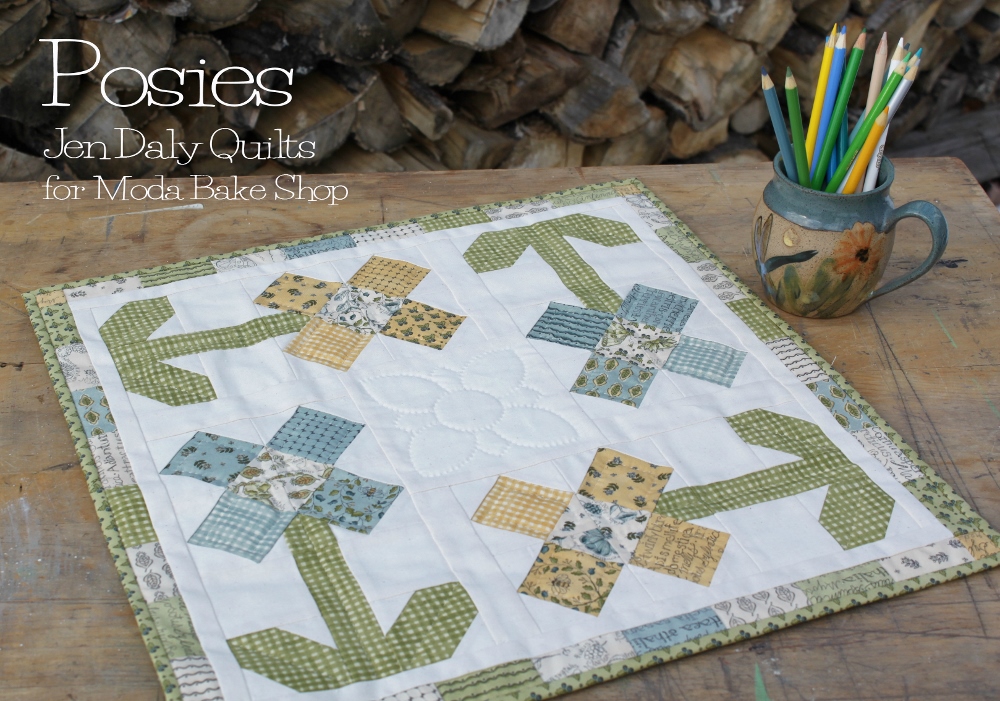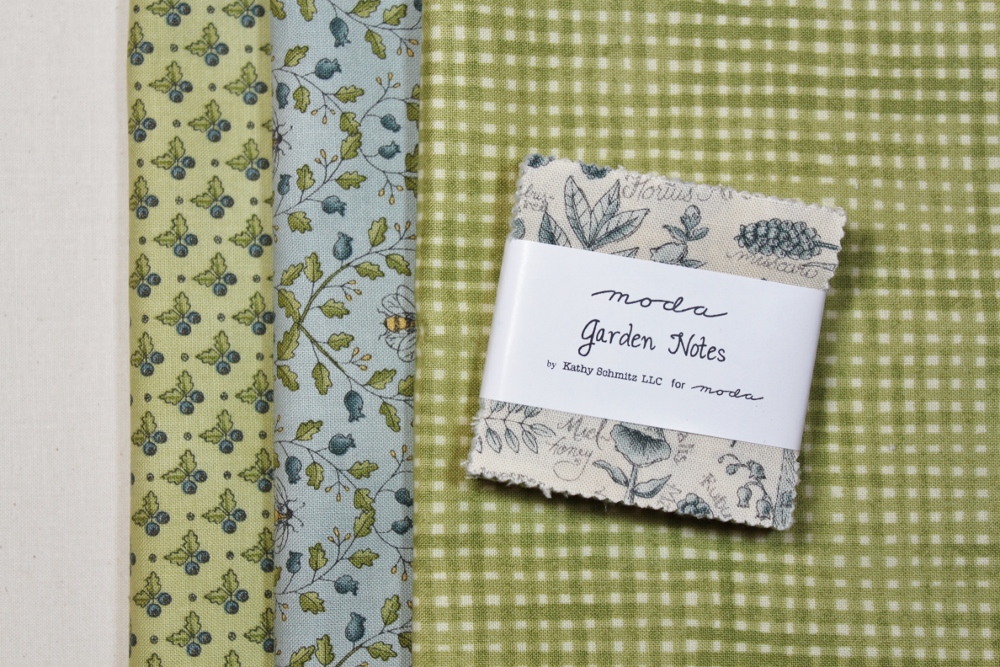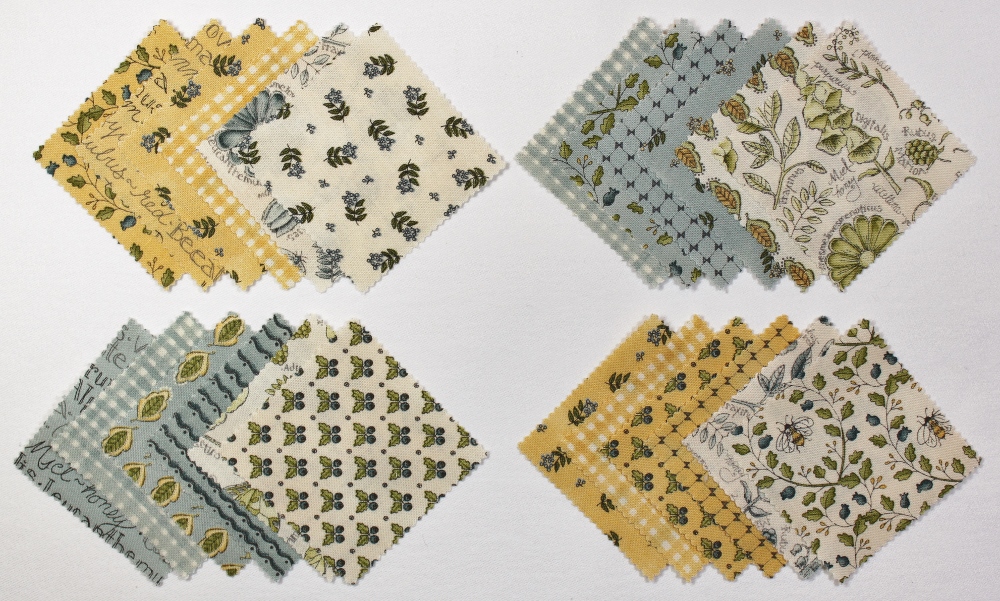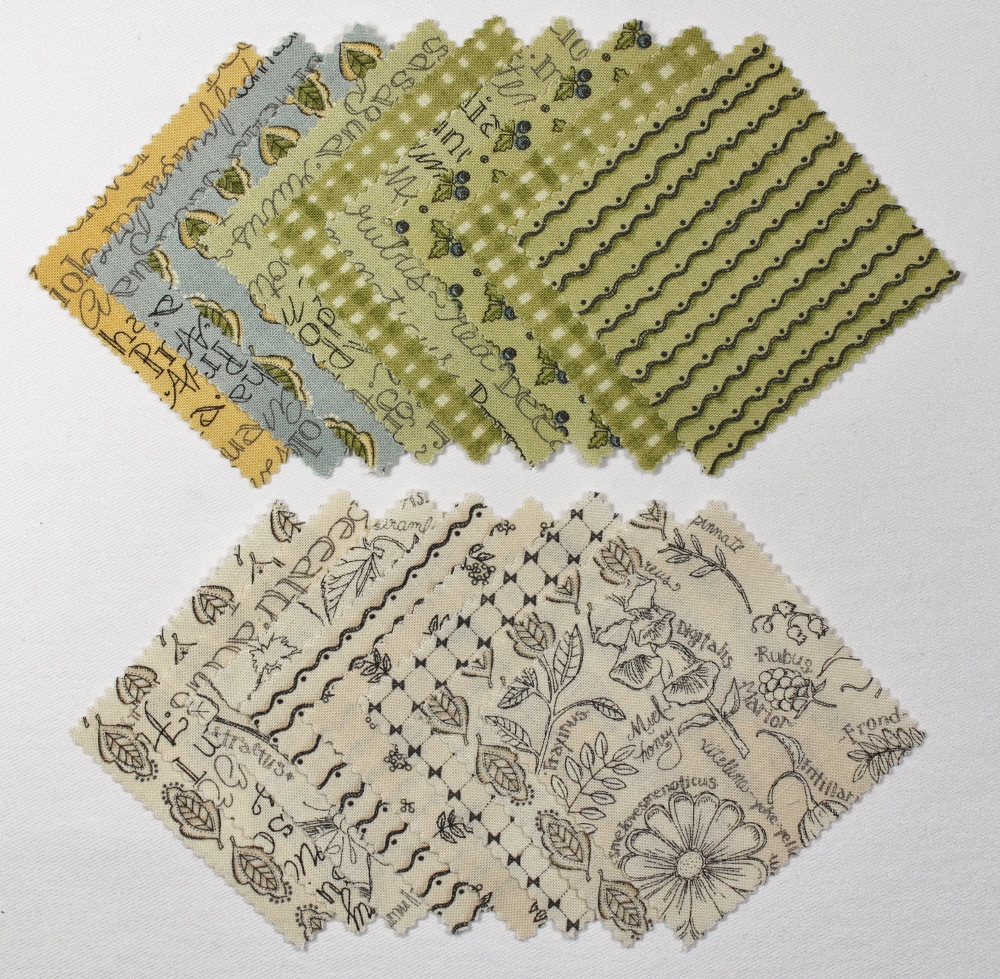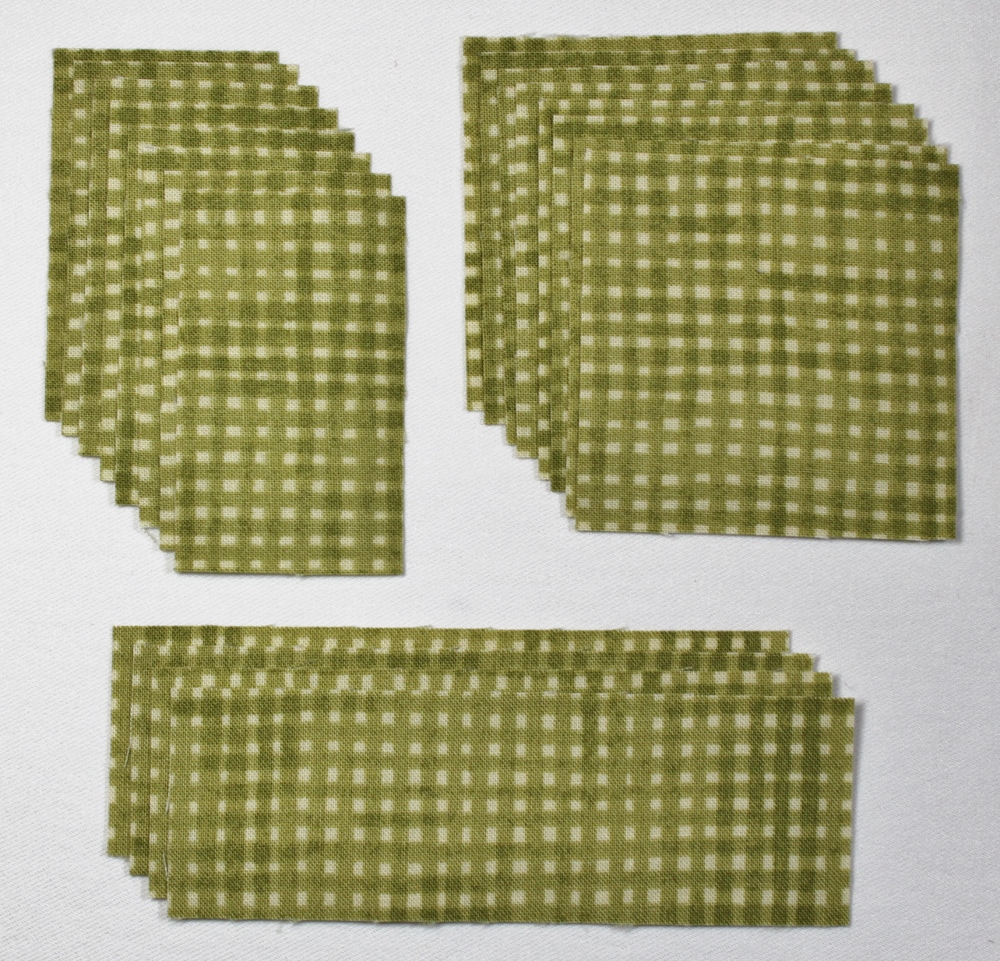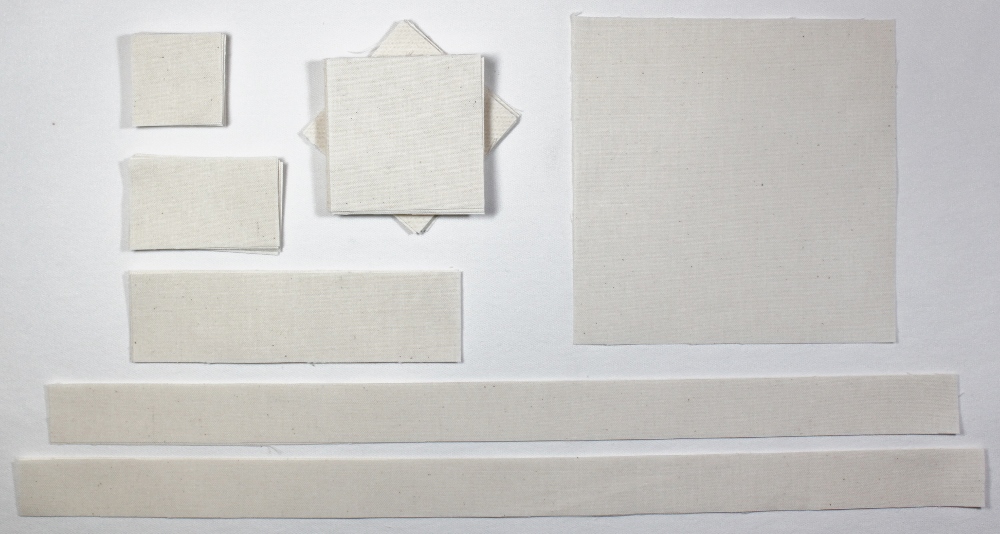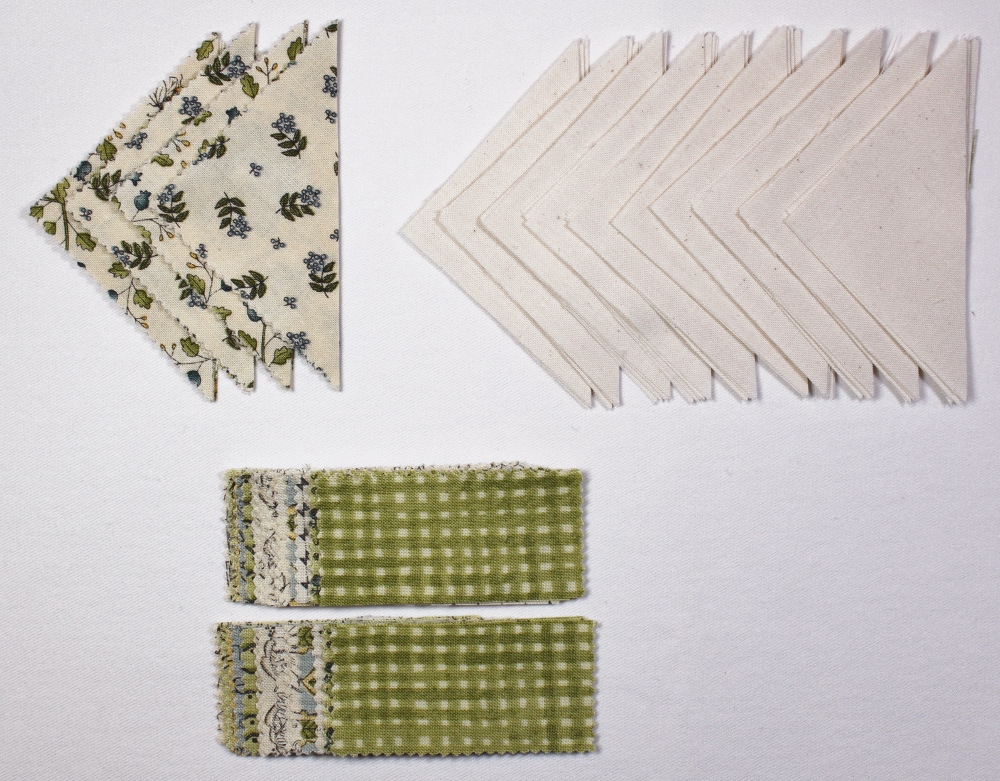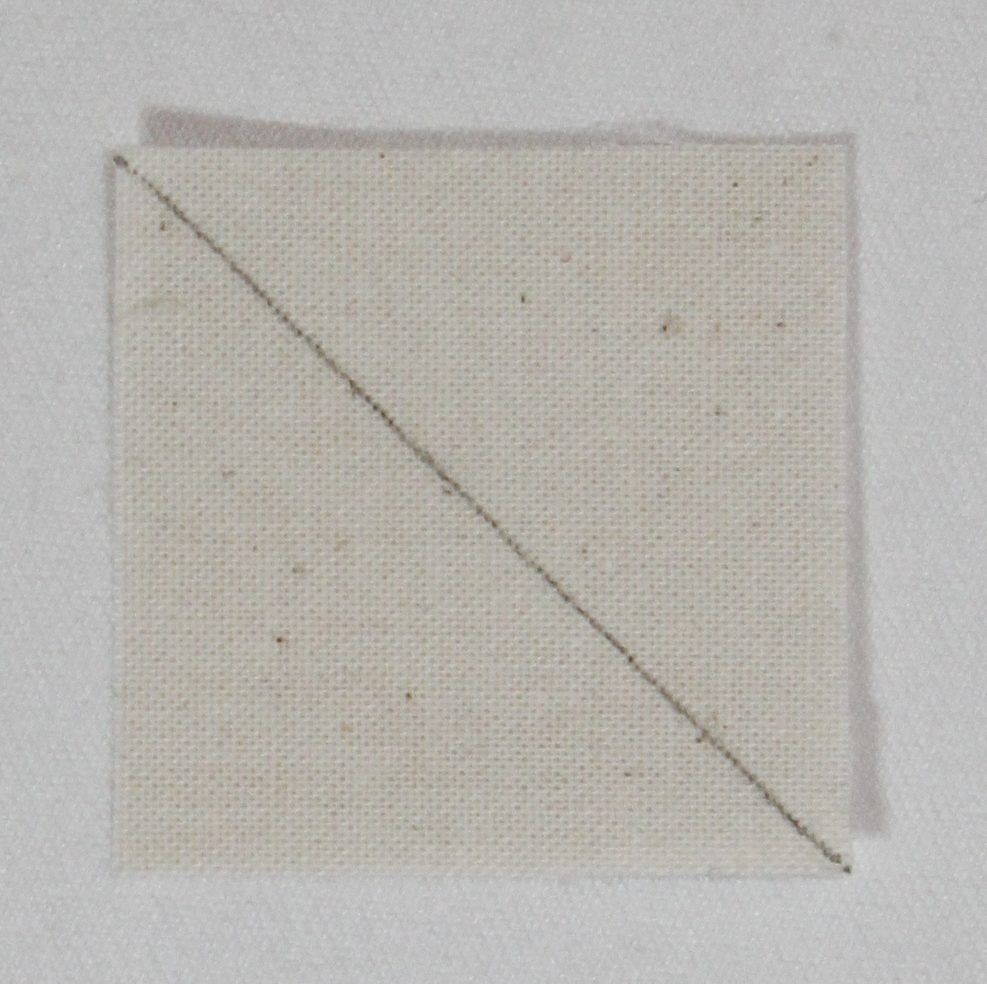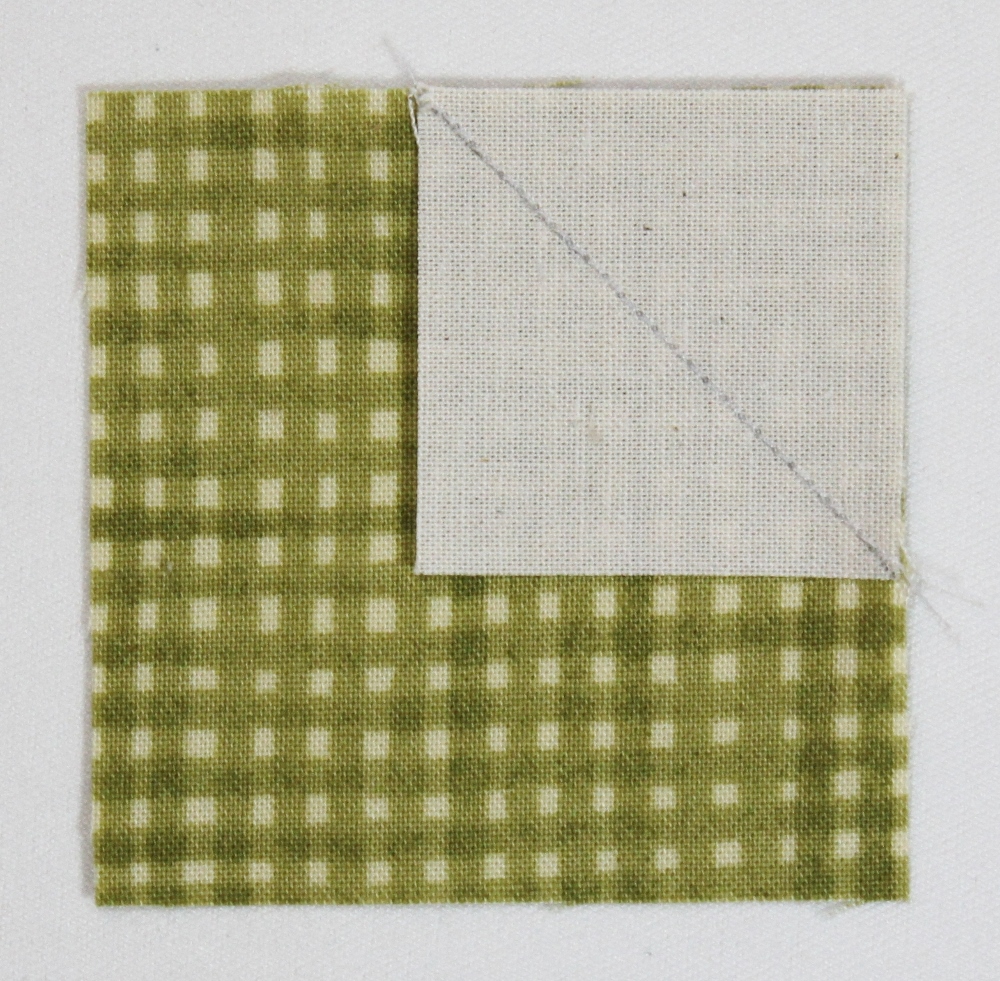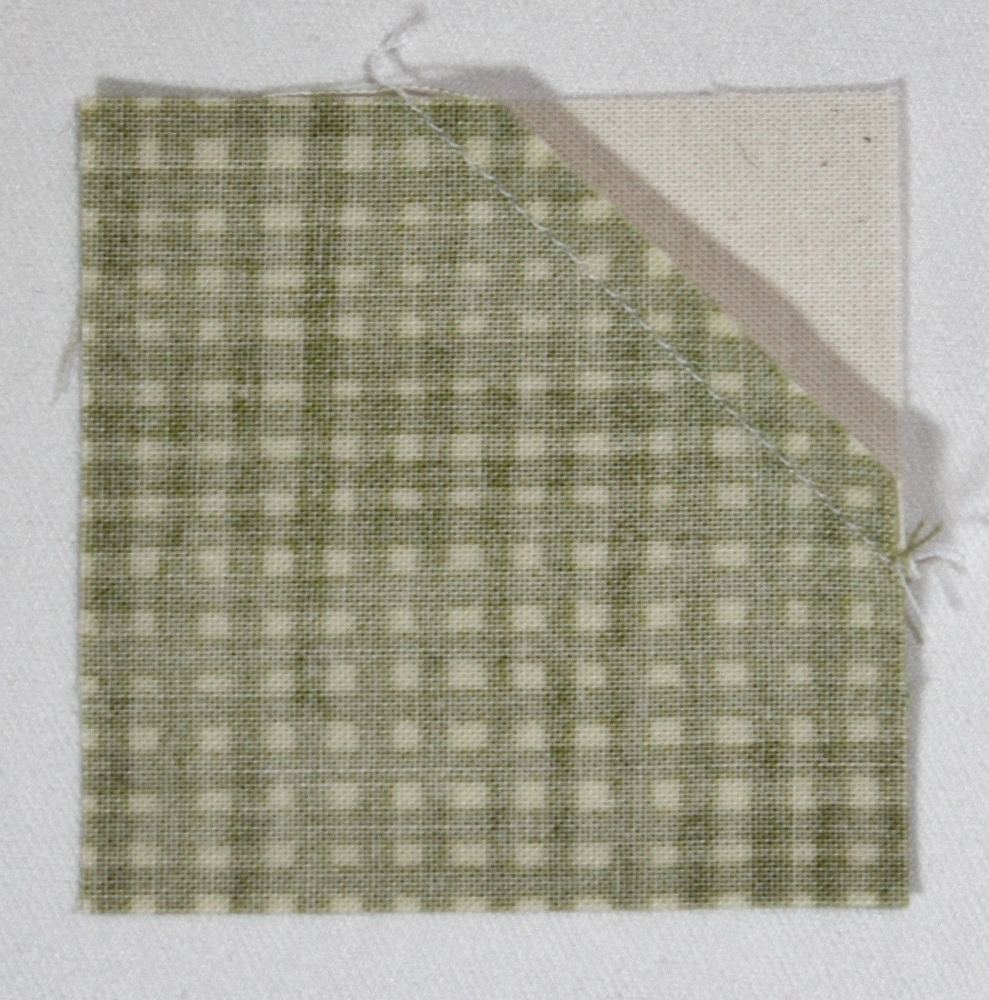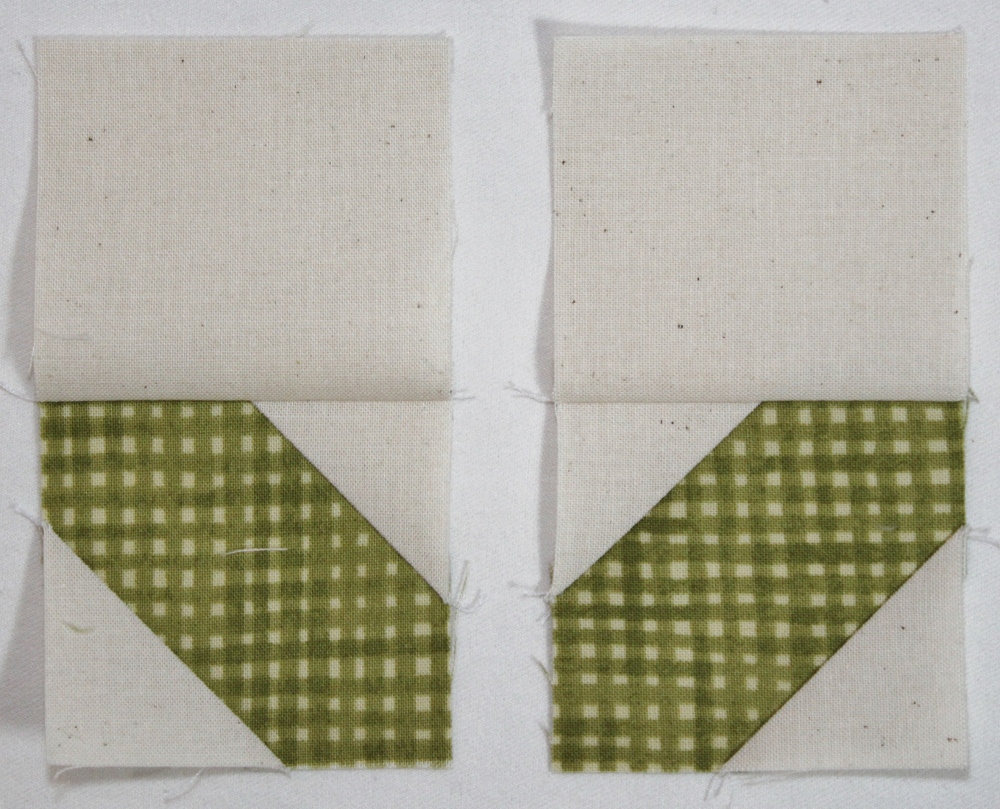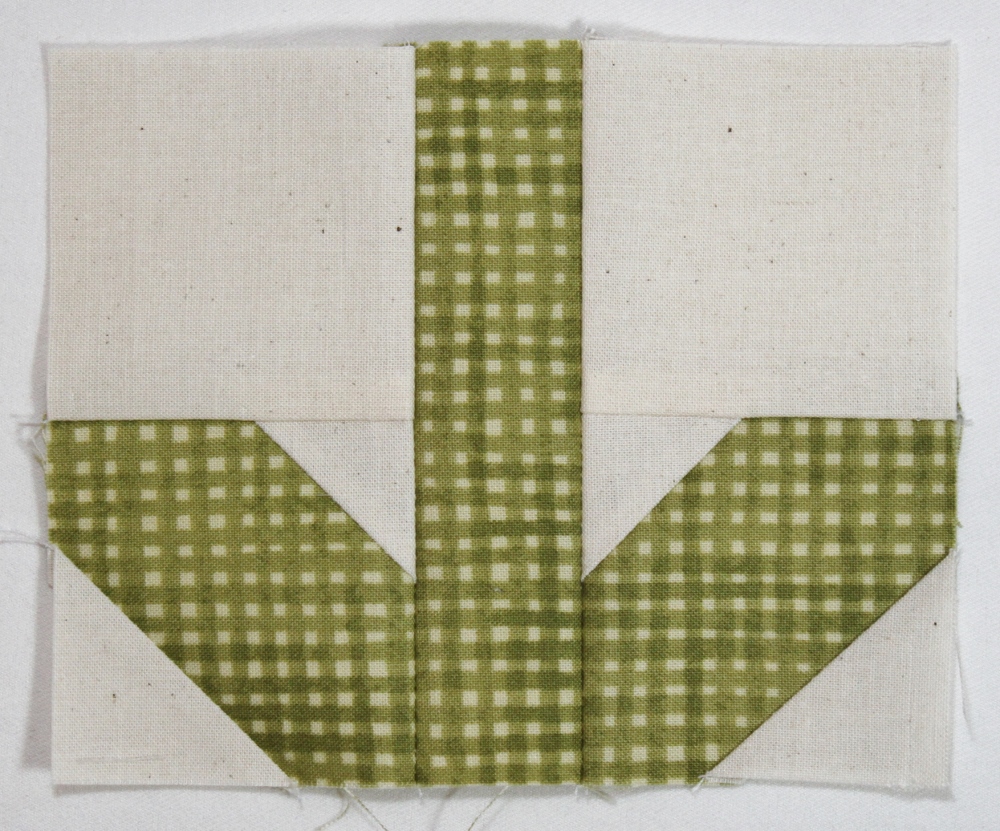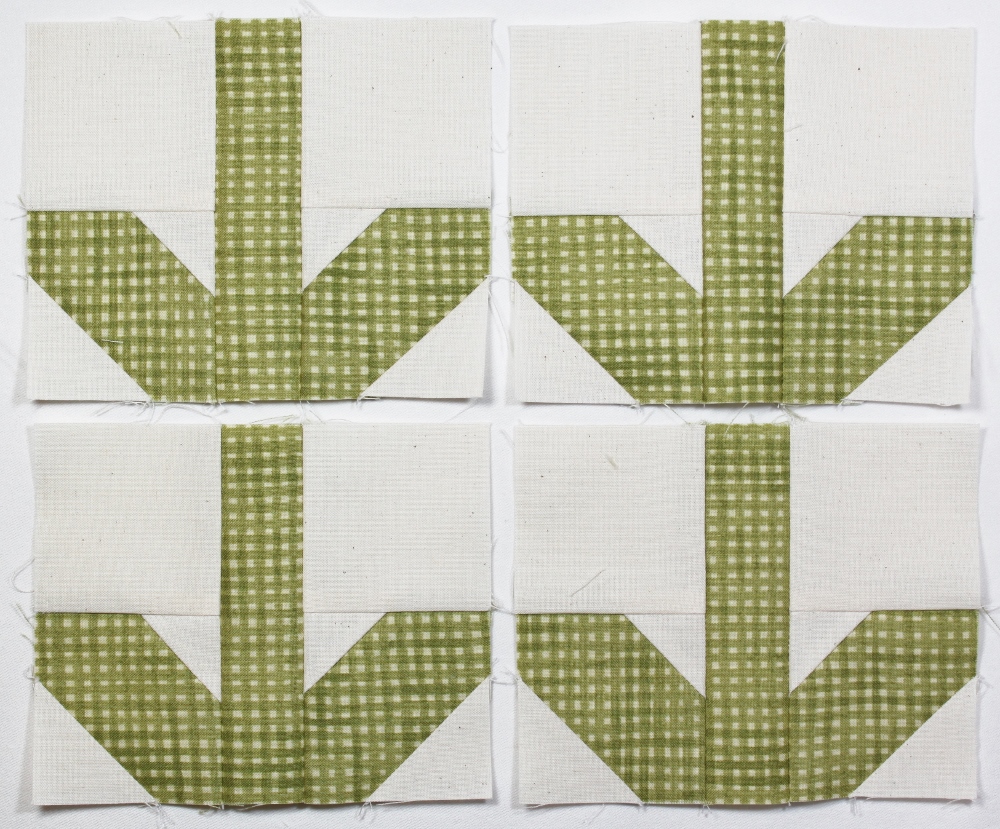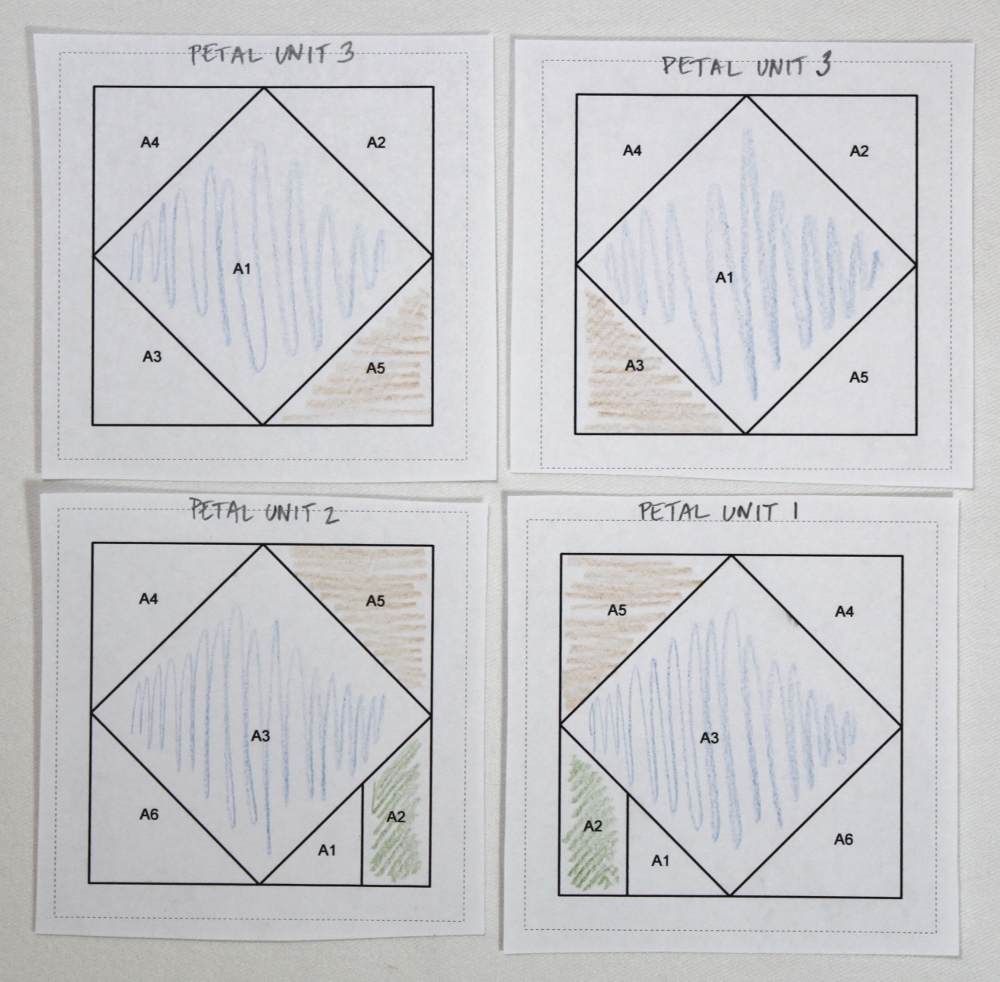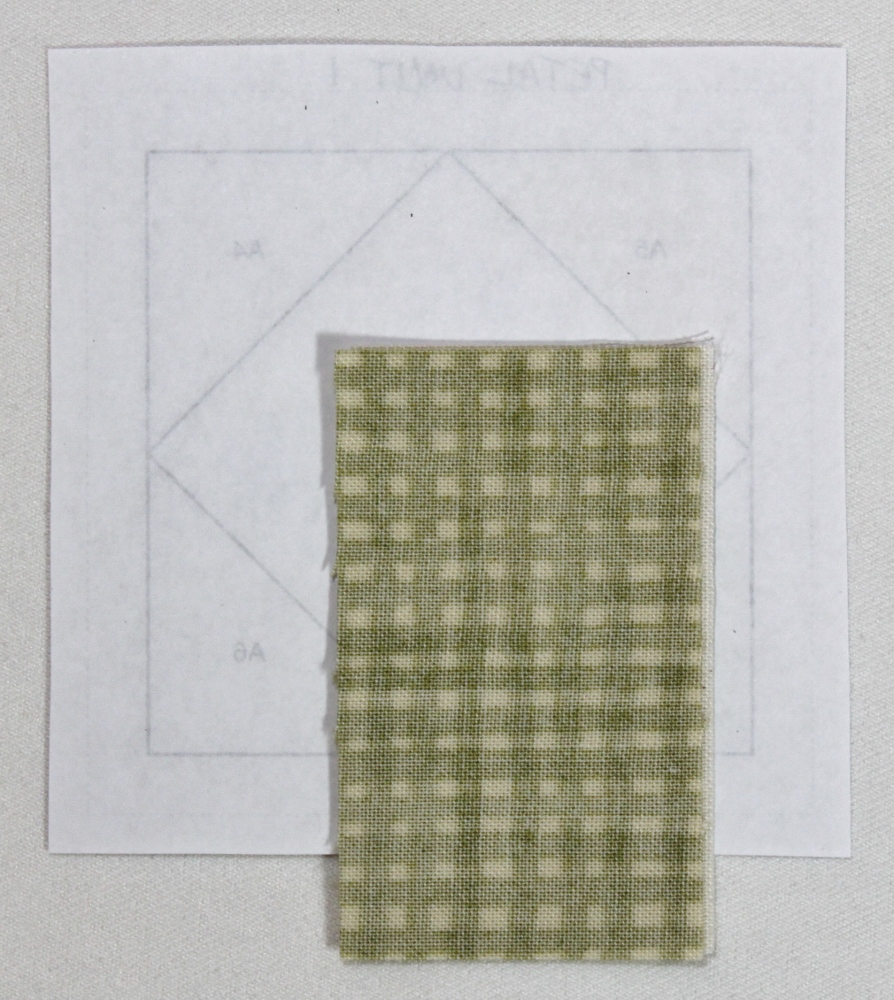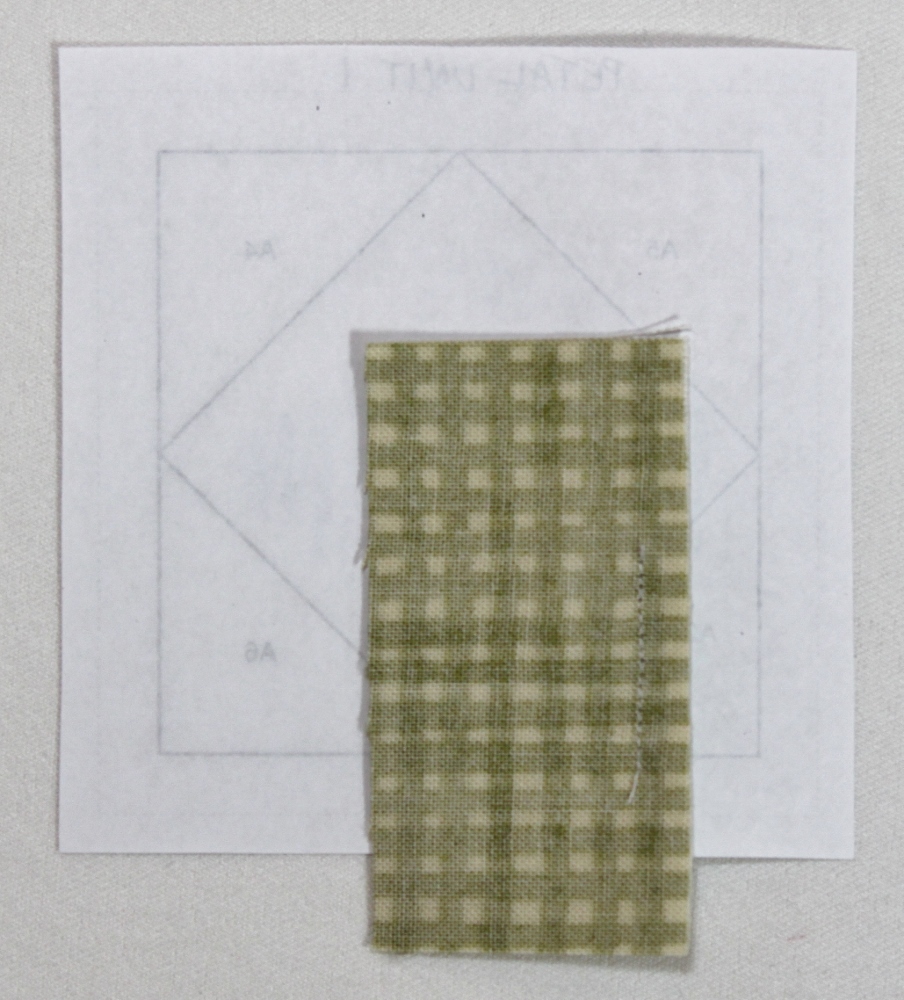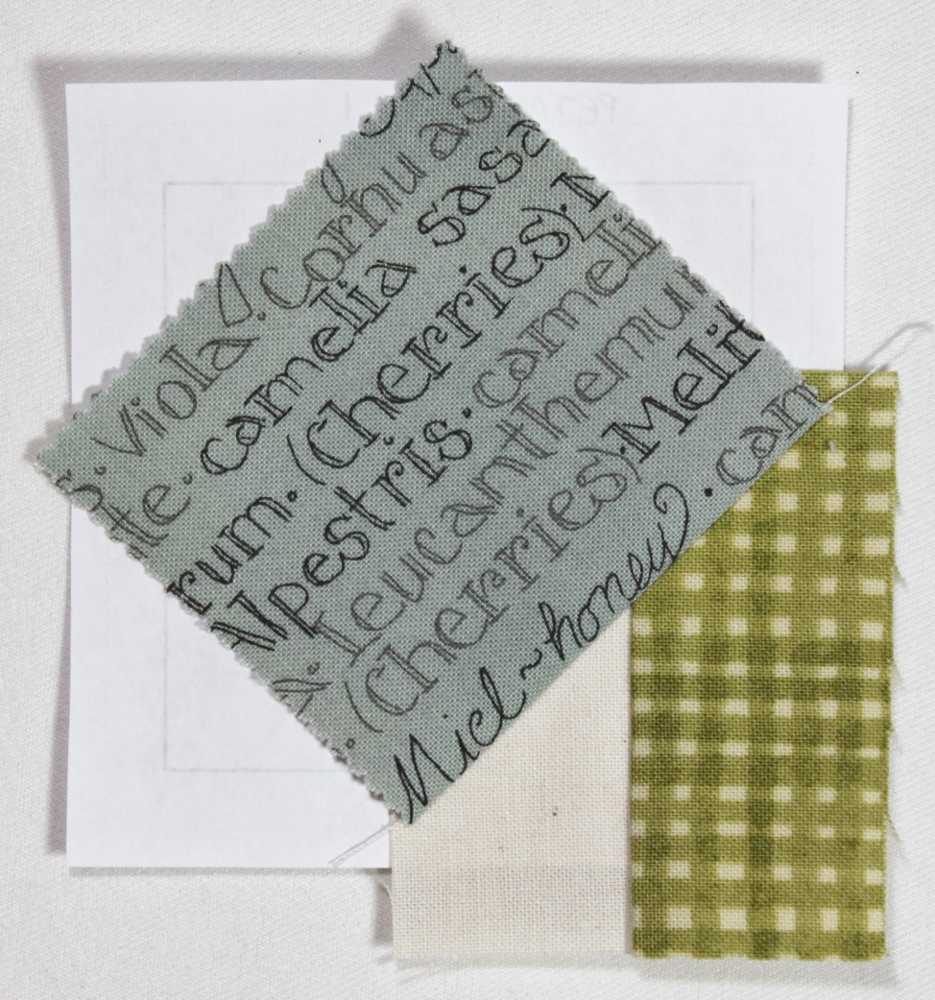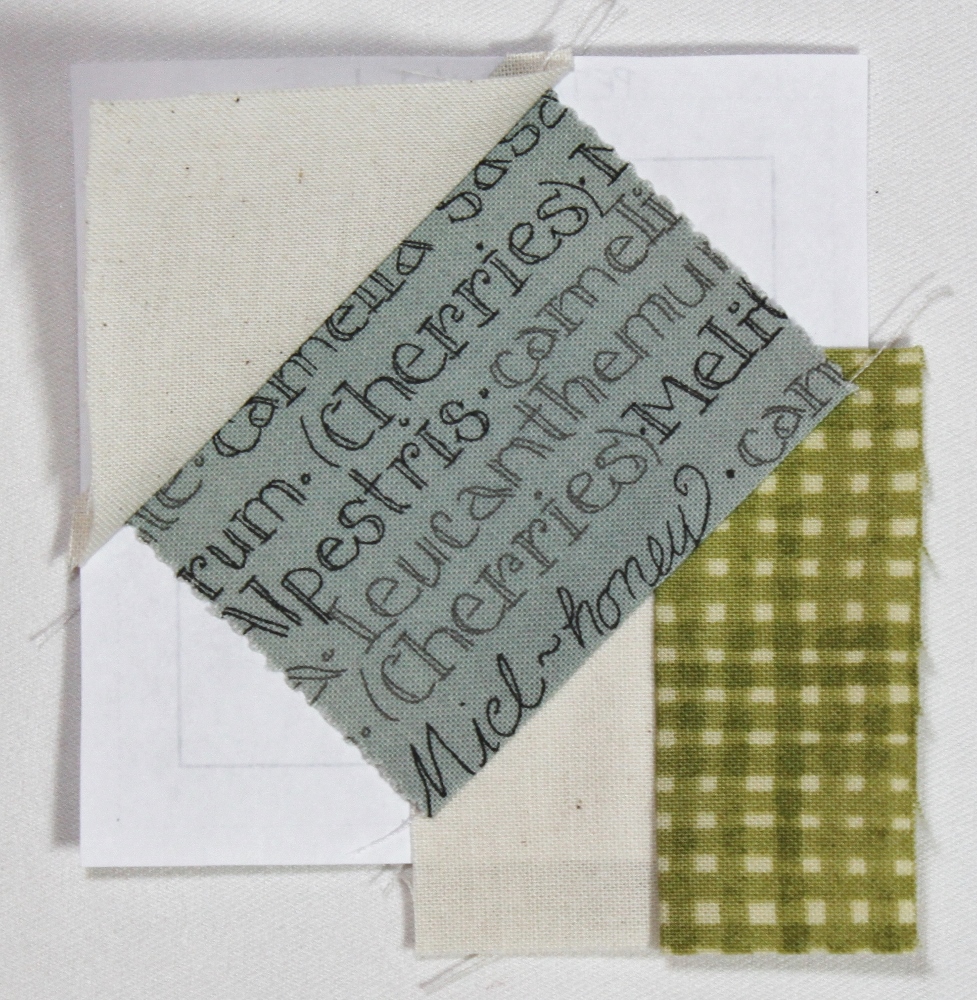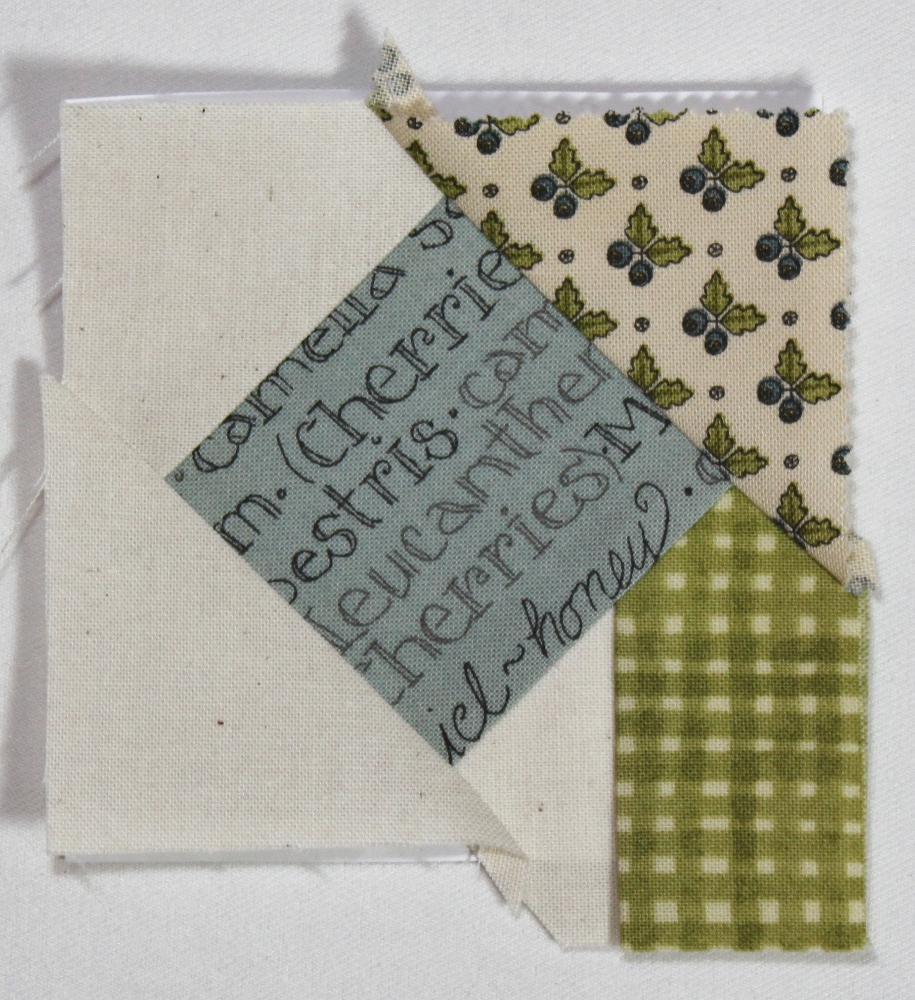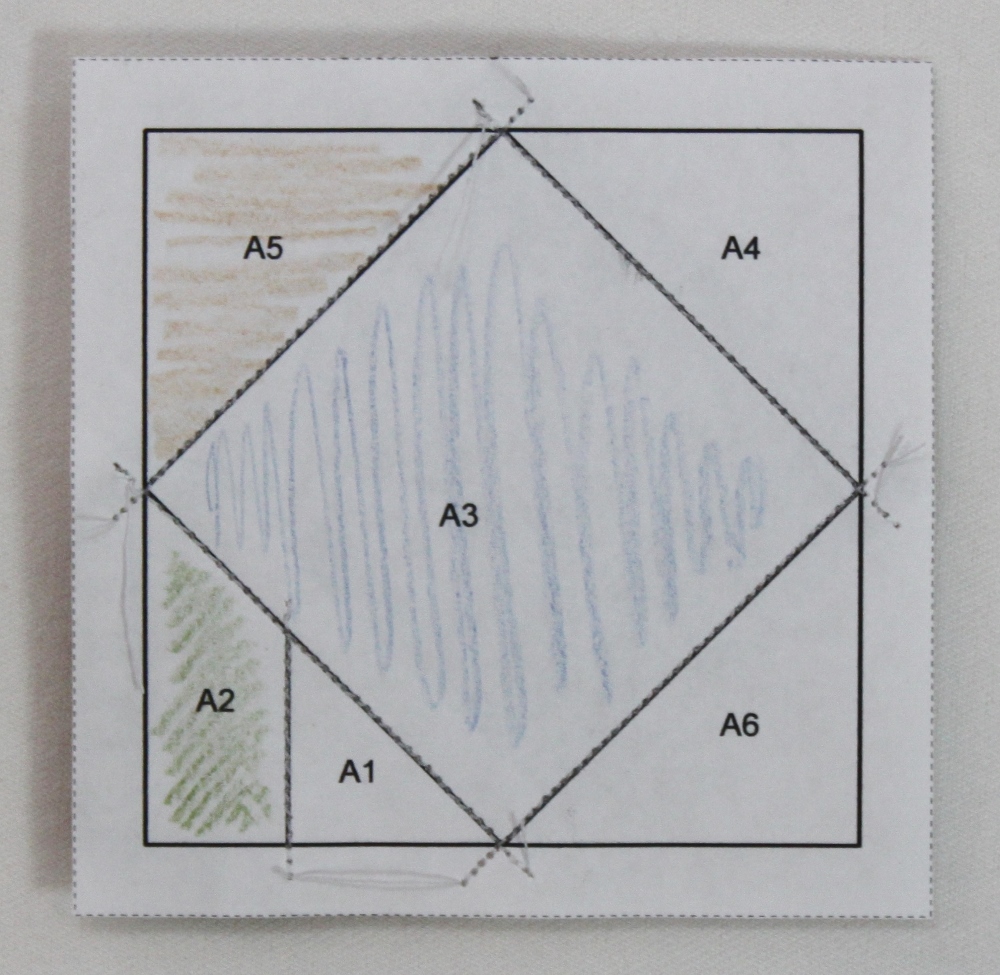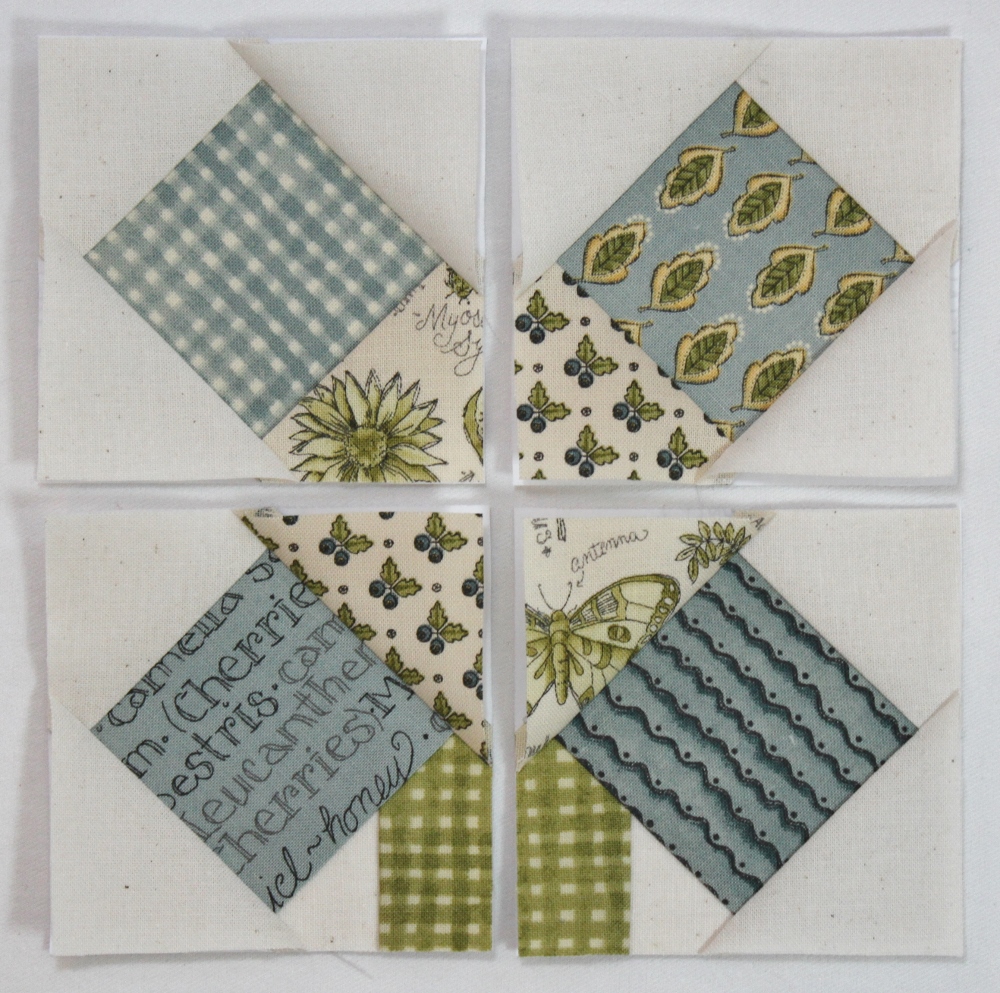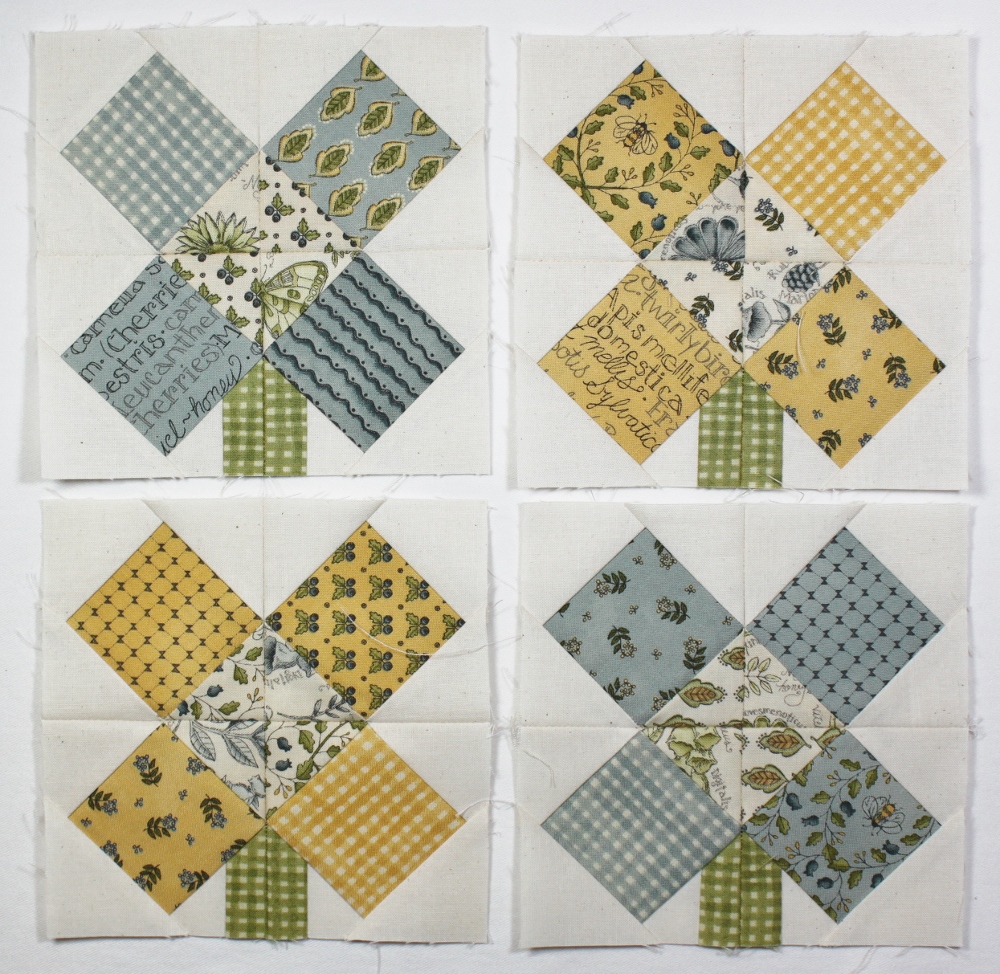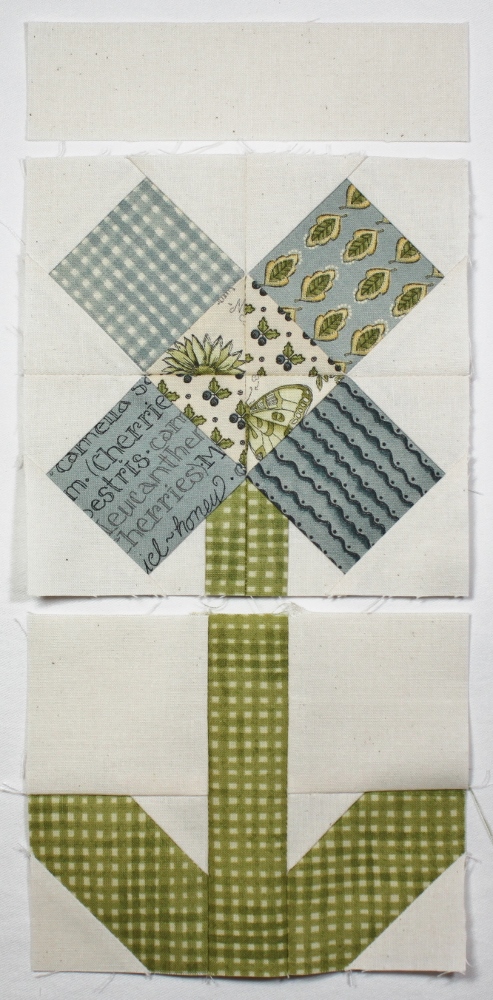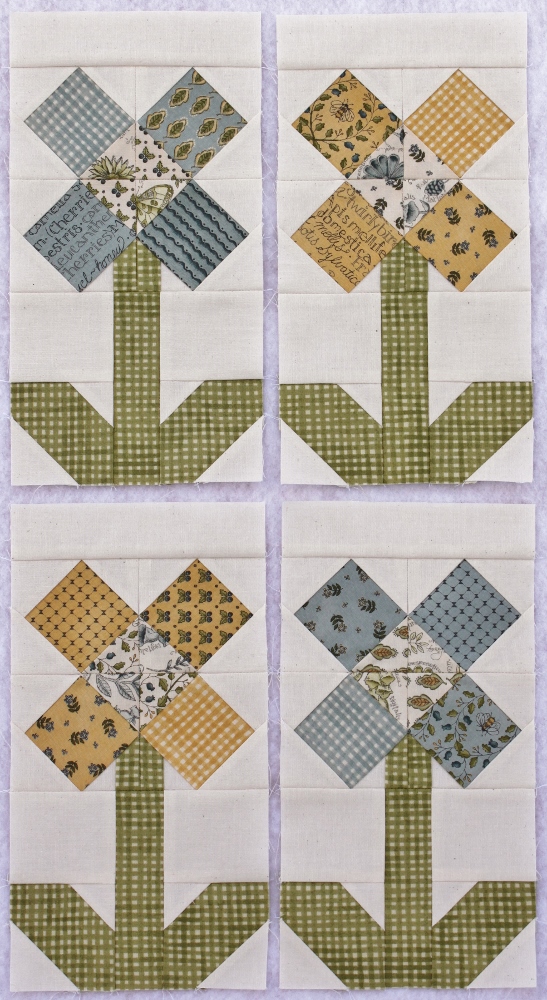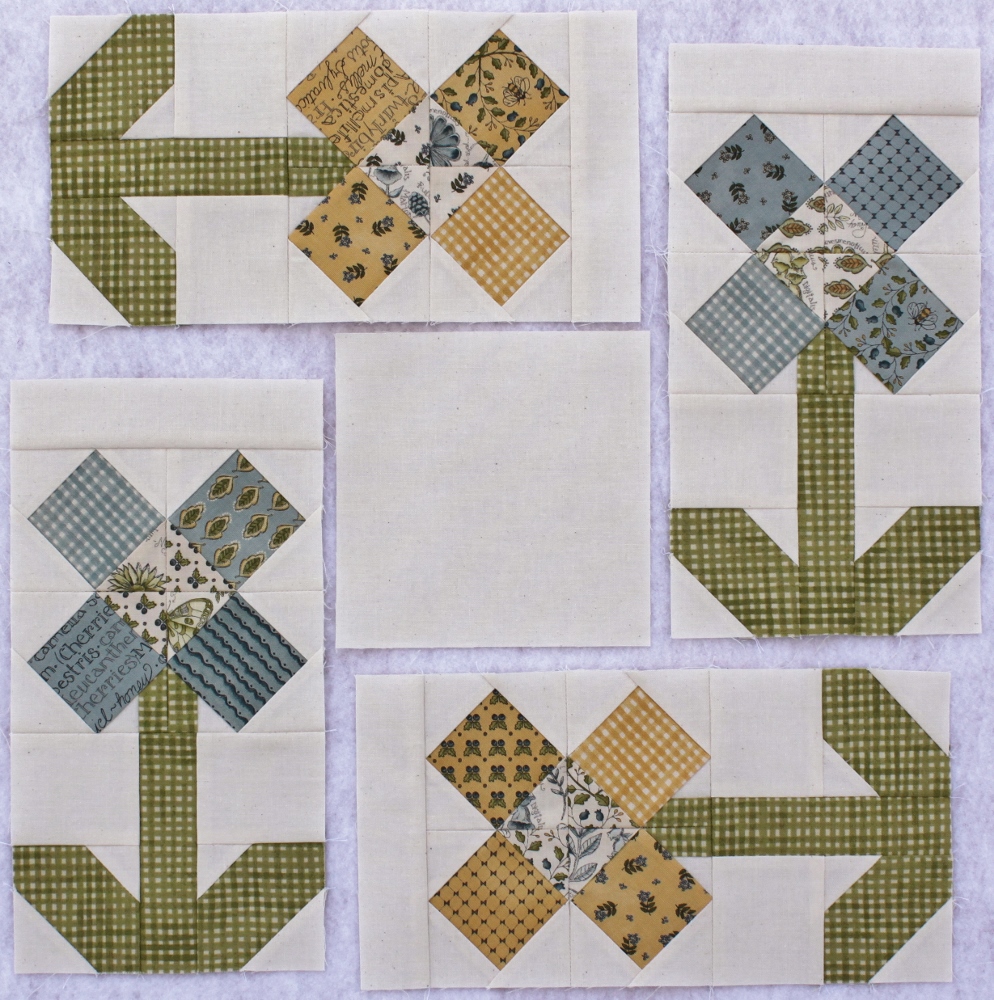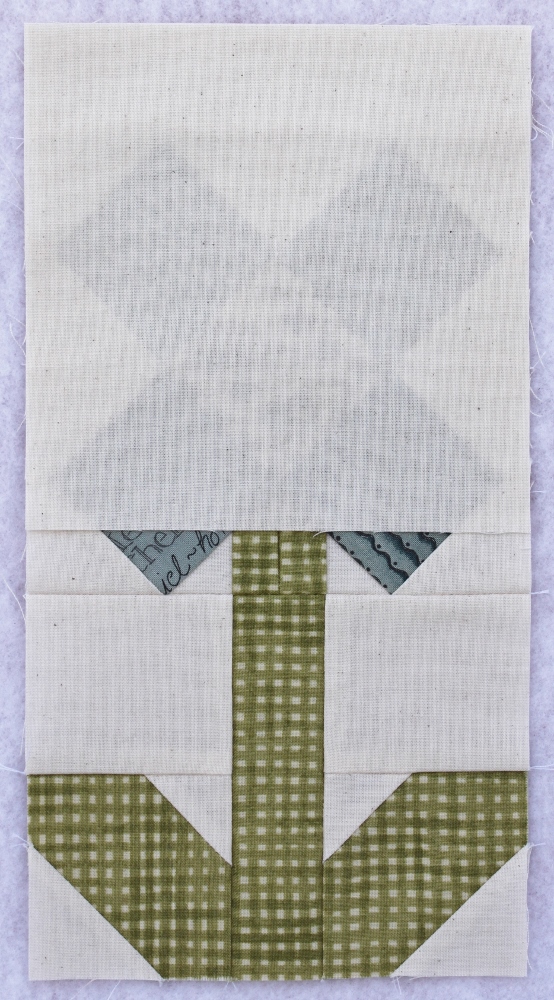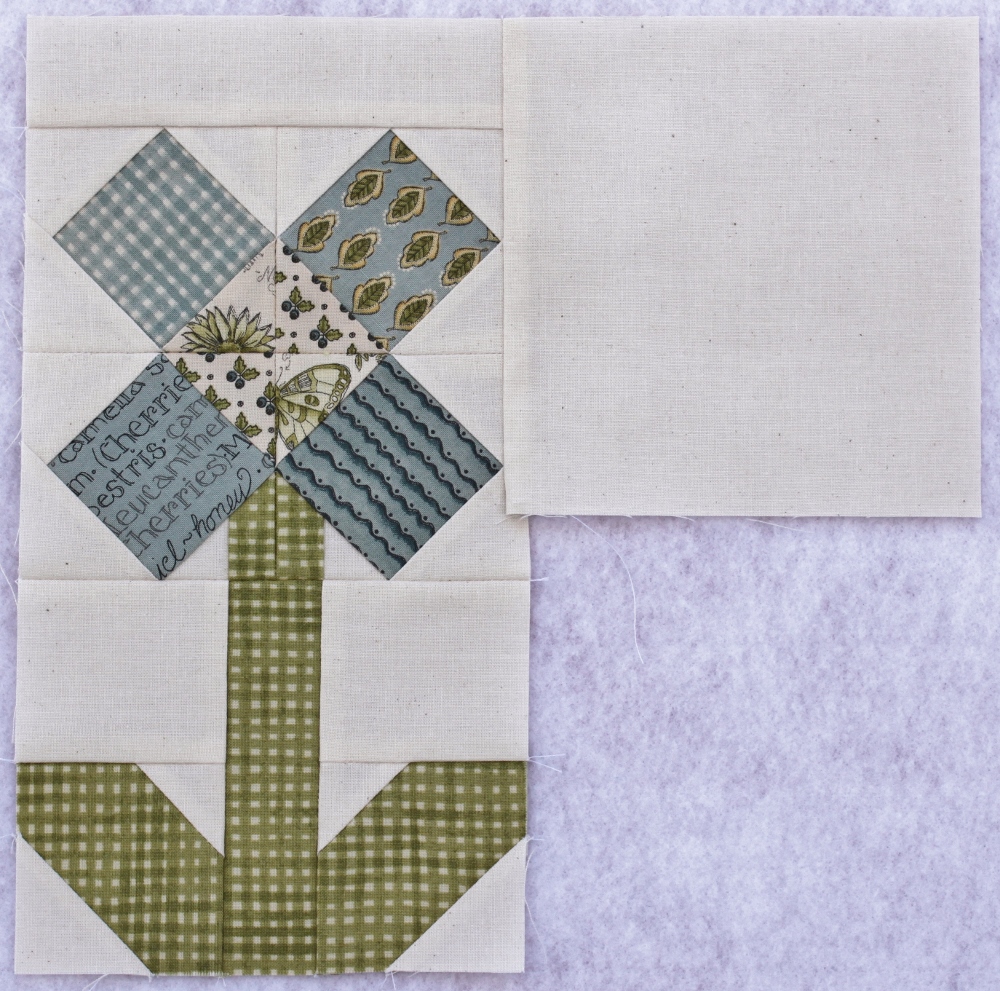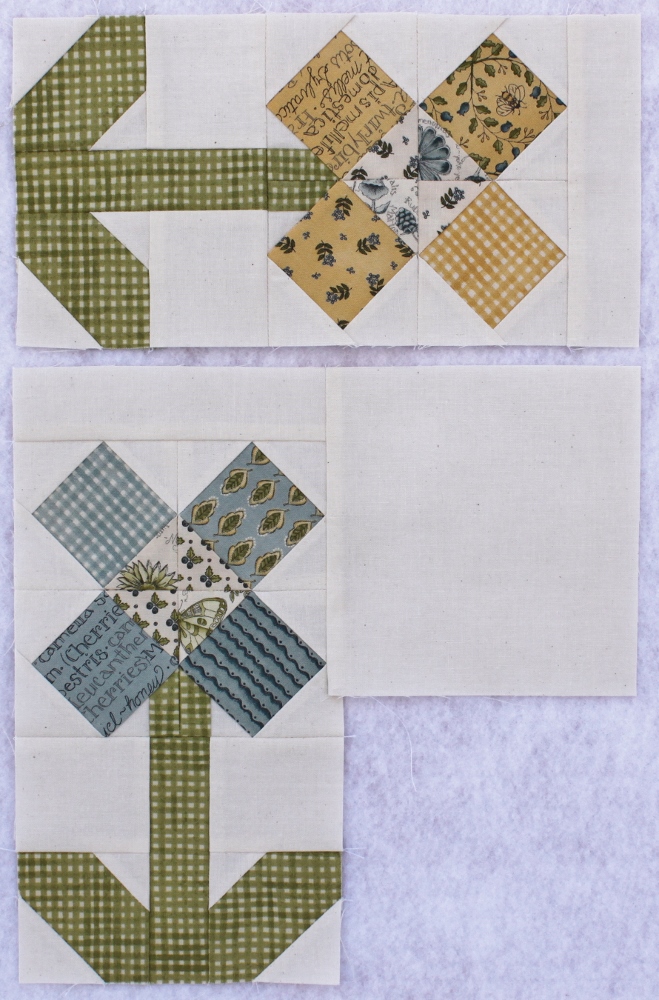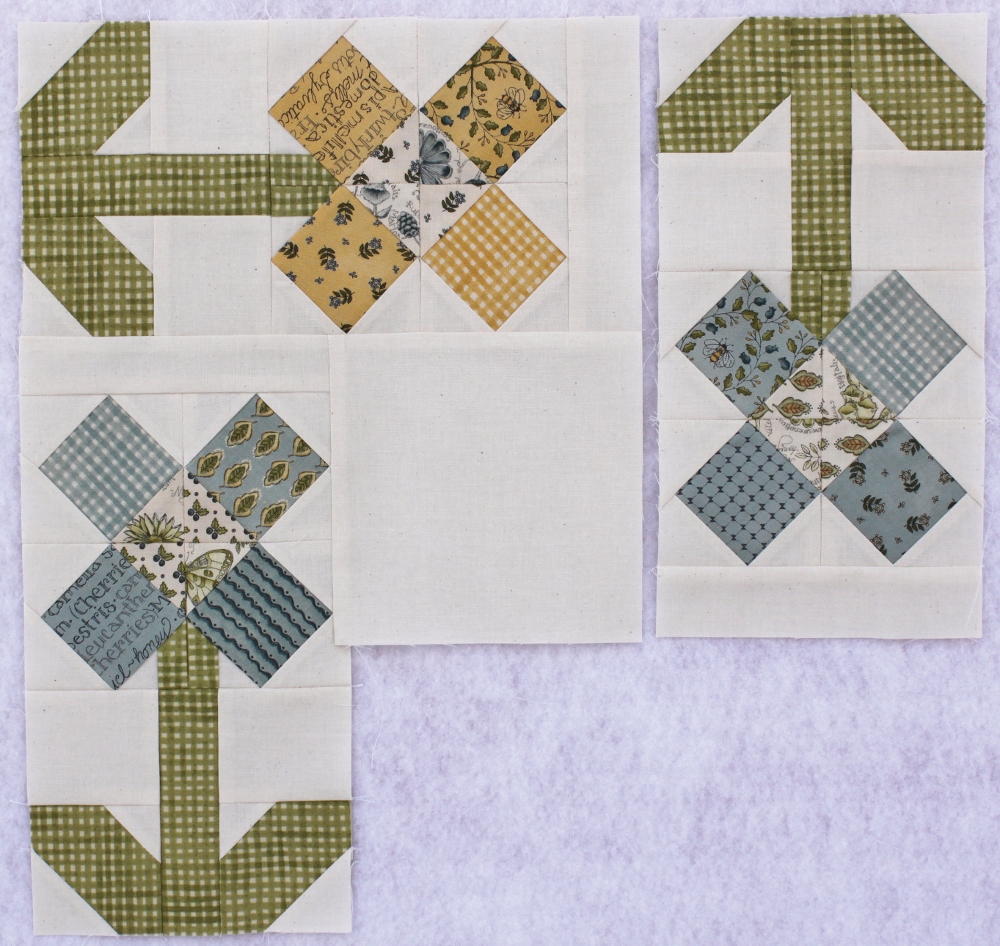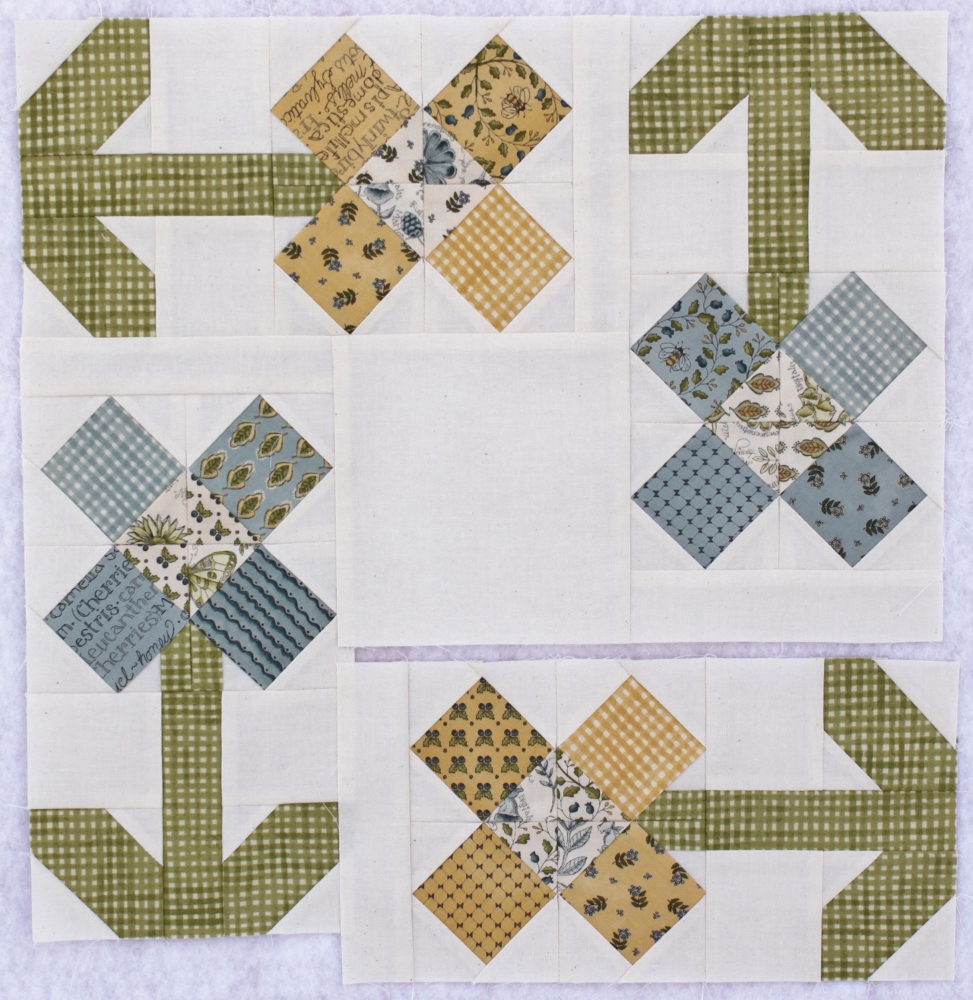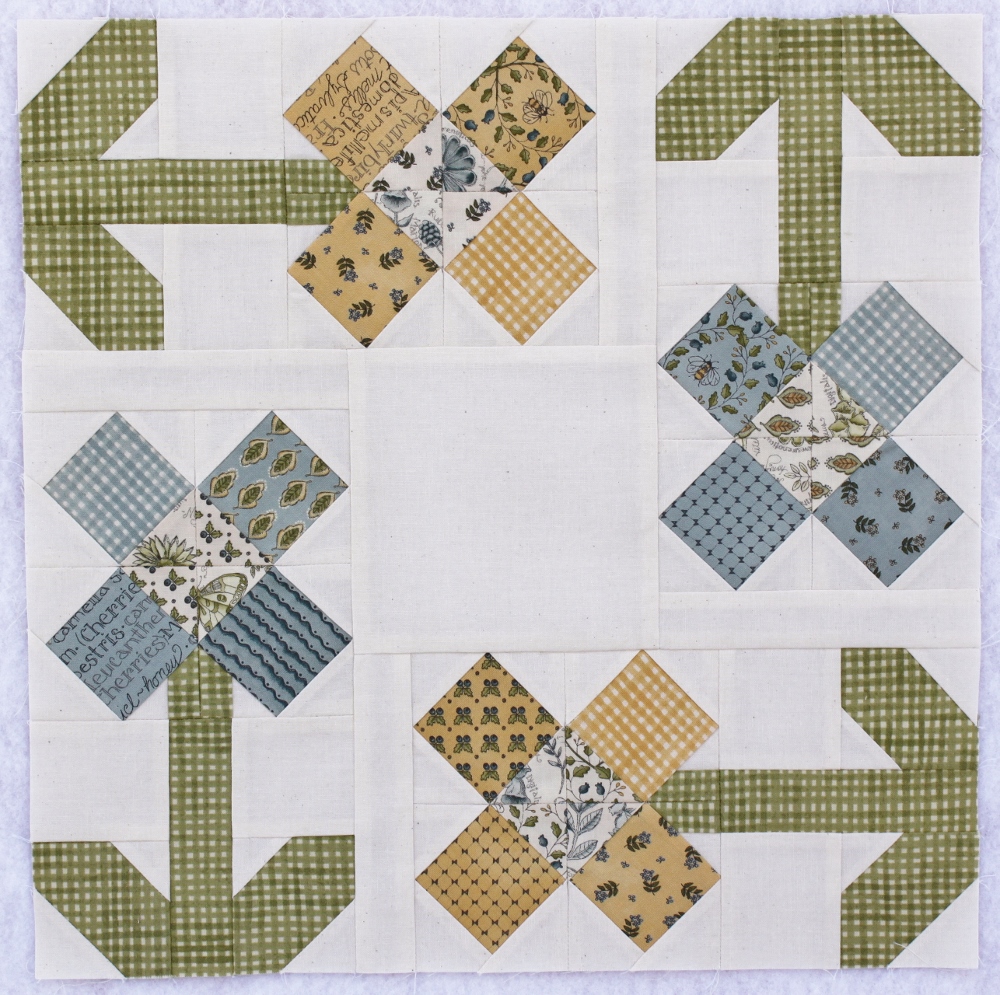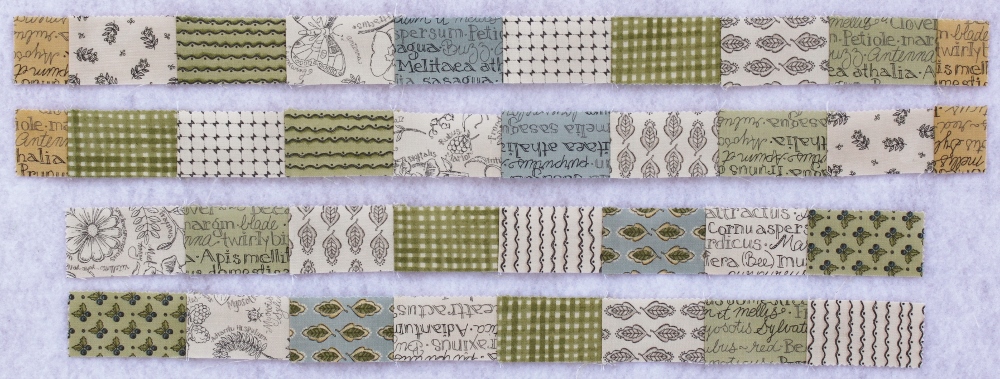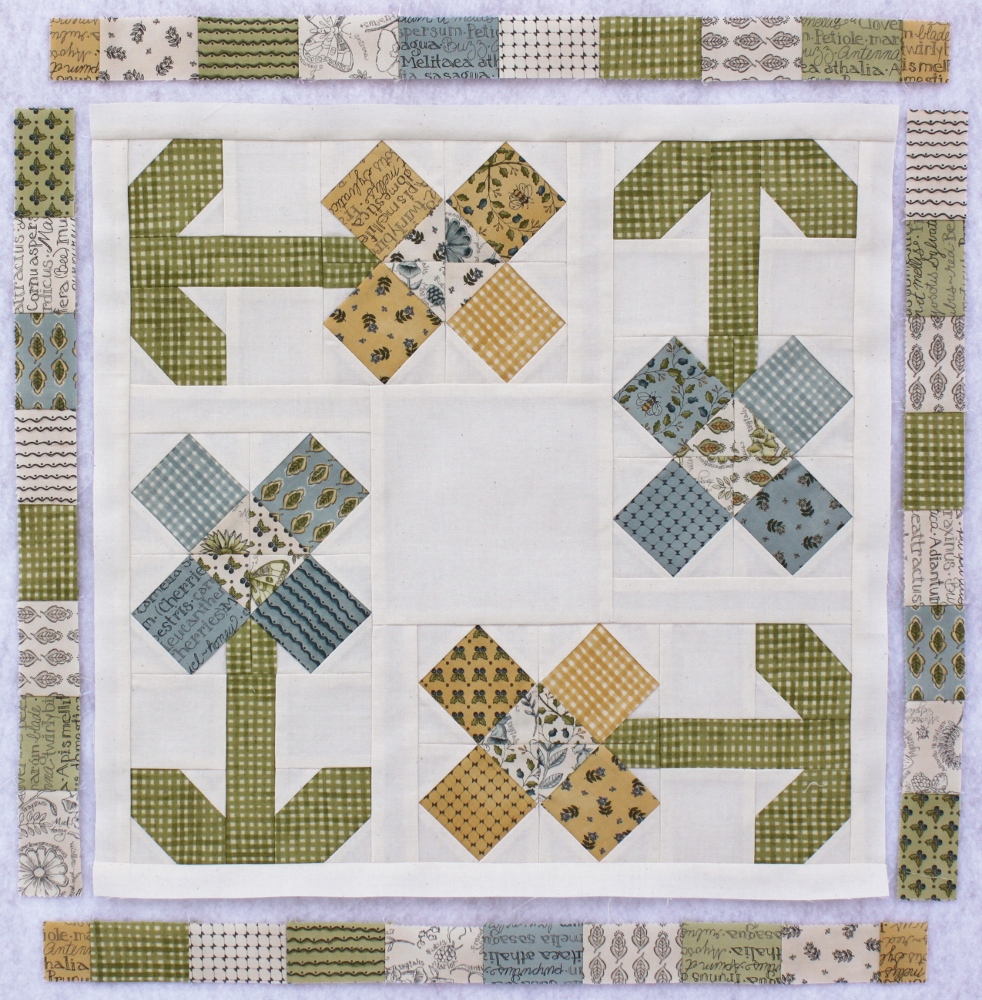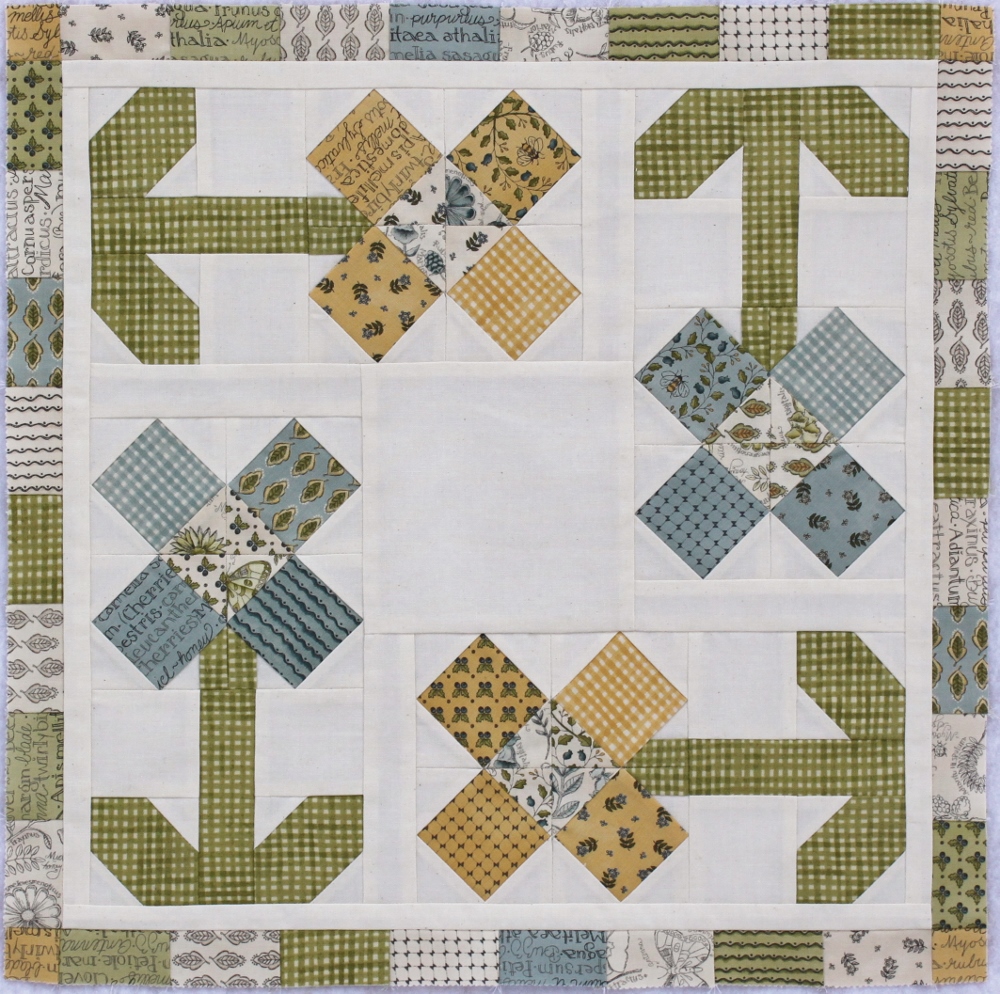Welcome to Moda Fabrics!
Posies Mini Quilt
Posies Mini Quilt
Hey there, fellow quilters! My name is Jen Daly and I'm so happy to be back at the Moda Bake Shop today with Posies, my new mini charm pack project! I made my little quilt with Kathy Schmitz's "Garden Notes" fabric, and in chilly New Hampshire, working with this gorgeous fabric has been like a breath of fresh air!
This pretty quilt finishes at 18" square. It's a fast and easy project—perfect for last minute sewing and gift giving!
Here we go...
1 Mini Charm Pack (shown in Garden Notes by Kathy Schmitz for Moda—6090MC)
1/6 yard (or one Fat Quarter) green print (shown in Garden Notes—6096 14)
1/2 yard background fabric (shown in Bella Solids Muslin Unbleached—9900 285)
2/3 yard backing fabric (shown in Garden Notes Morning Glory Blue—6093 11)
1/6 yard binding fabric (shown in Garden Notes Fern Green—6092 12)
batting measuring 20" x 20"
Before you begin, it may help to take a few minutes to sort your mini charm squares. You'll need 24 mini charm squares for the flowers (6 for each—4 for the petals and 2 for the centers) and 17 for the pieced border.
Here are the charm squares I chose for my flowers:
And here are the charm squares I reserved for my pieced border:
Cutting:
From your green print fabric, cut the following:
- 8—1½" x 2½" rectangles
- 8—2½" x 2½" squares
- 4—1½" x 4½" rectangles
From your background fabric, cut the following:
- 2—1" x 15½" strip (inner border)
- 2—1" x 16½" strip (inner border)
- 16—1½" x 1½" squares
- 8—1½" x 2½" rectangles
- 28—2½" x 2½" squares
- 4—1½" x 5½" rectangles
- 1—5½" x 5½" square
Make the following additional cuts:
- Cut the 8 mini charm squares that you plan to use as flower centers in half once diagonally from corner to corner to make 16 triangles.
- Cut 20 background fabric 2½" x 2½" squares in half once diagonally from corner to corner to make 40 triangles.
- Cut the 17 mini charm squares that you plan to use as your pieced border in half to form 34—1¼" x 2½" rectangles.
You'll also need to cut:
- From your backing fabric: 1—22" x 22" panel
- From your binding fabric: 2 strips 2¼" by WOF (width of fabric)
Assemble leaf/stem units:
- On the back of 16—background fabric 1½" x 1½" squares, use a pencil to lightly draw a line diagonally from one corner to the other.
2. Layer a marked background fabric 1½" x 1½" square atop 1 green print 2½" x 2½" square as follows and stitch on the drawn line.
3. Press seam allowance open towards the background fabric and trim seam allowance to ¼".
4. Repeat steps with a second marked background fabric 1½" x 1½" square at the opposite corner of the green print 2½" x 2½" square.
5. Repeat steps 2-4 to make 8 leaf units measuring 2½" x 2½" unfinished.
6. Stitch 1 background fabric 2½" x 2½" square to each of 2 leaf unit as shown. Make sure that 1 leaf unit slants towards the left and 1 leaf unit slants towards the right. Press seam allowance towards background fabric square.
7. Stitch together the 2 units created in step 6 above and 1 green print 1½" x 4½" rectangle as follows, pressing seam allowance towards leaves.
8. Repeat steps 2-7 to make 4 stem/leaf units measuring 4½" x 5½" unfinished.
Assemble flower units:
We'll be paper piecing the flower units, so here are a few of my paper piecing tips. If you’re new to paper piecing, you might find it helpful to check out some online video tutorials first—YouTube has several.
- When positioning fabric shapes for sewing, it helps to hold the foundation pattern and fabric shapes up to a light source (window, light box, lamp) to check your positioning.
- Shorten your stitch when paper piecing to 18-20 stitches per inch. This helps you to more readily remove the paper from the back of your work when you’re finished.
- Foundation papers specifically designed for paper piecing are great to work with and much easier to remove from your finished work. If you don’t have access to foundation paper and decide to use regular copy paper, just be very careful when removing it from the back of your work to make sure you don’t pull out your stitches.
- Start sewing a couple of stitches before each sewing line and stop a couple of stitches beyond each sewing line.
Each flower unit is made of 4 separate petal units. Here's a link to a pattern sheet containing the 4 petal unit foundation patterns. You'll need to print off one sheet for each flower. Before you begin, make sure that the foundation patterns measure 3" x 3" from outermost line to outermost line.
To stay organized, you may want to quickly color of few areas of your petal unit foundation patterns as shown. I colored the center diamonds blue for the flower petals, the inner triangles beige for the flower centers, and the A2 areas of Petal Units 1 and 2 green for the flower stems.
I'll demonstrate paper piecing with petal unit 1. Ok, let's get started!
- Lay a petal unit 1 foundation pattern right side down on a flat surface. Position the background fabric 1½" x 2½" rectangle right side up on the blank side of the paper, making sure that it completely covers section A1 and extends at least ¼" beyond all sides of section A1. You can pin the rectangle in place if you like.
2. Position 1 green print 1½" x 2½" rectangle atop the background fabric 1½" x 2½" rectangle with right sides together. The long side of the rectangle should run parallel to the line between sections A1 and A2 and should extend into section A2 by at least ¼". Position the green print rectangle in such a way that when folded over after sewing, it will completely cover section A2 and extend at least ¼" beyond all edges of the section.
3. Flip your work over and stitch directly on the line between sections A1 and A2. Press seam. Flip your work over again and trim seam allowance to a scant ¼".
4. Open fabric and press again. Before moving on to the next area, make sure that the green print rectangle covers area A2 completely, including an extra ¼" on each side.
5. Continue in the same manner, covering area A3 with a flower petal print mini charm square.
6. Cover area A4 with a background fabric triangle (cut diagonally from a background fabric 2½" x 2½" square).
7. Cover area A5 with a flower center print triangle (cut diagonally from a flower center print mini charm square).
8. Cover area A6 with a background fabric triangle (cut diagonally from a background fabric 2½" x 2½" square).
9. Flip work over and trim through all layers carefully along outermost line.
10. And here's what your finished petal unit 1 should look like.
11. In the same manner, paper piece 1—petal unit 2 and 2—petal unit 3s.
12. Repeat steps to make 3 more sets of petal units, 1 for each of the 4 flowers.
Assemble flowers:
- For each flower gather 4 paper pieced petal units and stitch together in rows to make 4 flower units measure 5½" x 5½" unfinished. Carefully remove the foundation paper from behind each flower unit.
2. Stitch together 1 background print 1½" x 5½" rectangle, one flower unit and one stem/leaf unit as follows to make a flower block measuring 5½" x 9½" unfinished. Press seam allowances away from flower unit.
3. Repeat to make 4 flower blocks.
Assemble quilt center:
- We'll be assembling our quilt center using a partial seam method. Lay out 4 flower blocks and 1 background print 5½" x 5½" square as follows:
2. Place the background print 5½" x 5½" square atop 1 flower block with right sides together as shown. Stitch together along right hand side of background print 5½" x 5½" square, starting at the background print 1½" x 5½" rectangle (top of flower), but stop sewing about 1" before the end of the seam.
3. Lightly press seam allowance towards the background print 5½" x 5½" square.
4. Stitch a second flower to the above unit as shown. This time stitch the full seam. Press towards center background fabric square.
5. Stitch a third flower to the above unit as shown. Press towards background fabric center square.
6. Stitch the fourth flower to the above unit as shown. Press towards background fabric center square.
7. Stitch the remaining seam, making sure to complete the first seam you sewed in step 2 above. Press seam towards background fabric center square.
8. Your finished quilt center should measure 15½" x 15½".
Add borders:
- Stitch 1—background fabric 1" x 15½" inner border strip to left and right side of quilt center, pressing seam allowance towards border. Then stitch 1—background fabric 1" x 16½" inner border strip to top and bottom of quilt, again pressing seams towards border.

2. Lay out 2 pieced border of 8—1¼" x 2½" rectangles each and 2 pieced borders of 8—1¼" x 2½" rectangles and 2—1¼" x 1¼" squares each (cross cut 2 pieced border 1¼" x 2½" rectangles in half to create the 4—1¼" x 1¼" squares necessary for this step).
3. Stitch pieced border strips together, pressing seam allowances all in one direction.
4. Stitch one short pieced border to left and right side of quilt center, pressing seams towards the inner borders. Stitch one long pieced border to top and bottom of quilt, pressing seams towards the inner borders.
And there you have it!
Finish quilt:
Layer the quilt top with batting and backing fabric. Baste, quilt as desired, and bind. I hand quilted a simple flower in the center square of my quilt for a bit of texture, and I quilted ¼" inside each flower petal and down the center of the stems and leaves.
One fresh and pretty 18" square little quilt!
And in the spirit of the season, I've got a little gift for you all! During the month of December, I'm hosting a Christmas Quilt-along at my blog, jendalyquilts.com. You can find photos of the Merry and Bright Quilt-along on Facebook and Instagram @jendalyquilts (#merryandbrightqal). It's not too late to join us!!
Happy Quilting and Happy Holidays!
Jen Daly
{jendalyquilts.blogspot.com}

